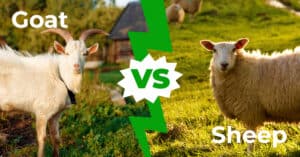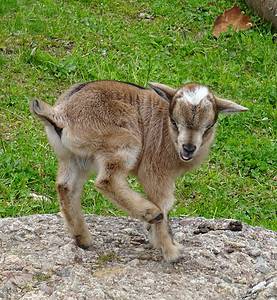When you look at goat horns, you may be thinking they’re just hollow appendages or dead bone. After all, horns can’t be that complicated, right? Wrong! These are living, sensitive growths that serve a variety of purposes from communication to defence to social domination. Sometimes, goats even use them to give their humans an affectionate headbutt! Read on to discover 10 things you should know about goat horns.
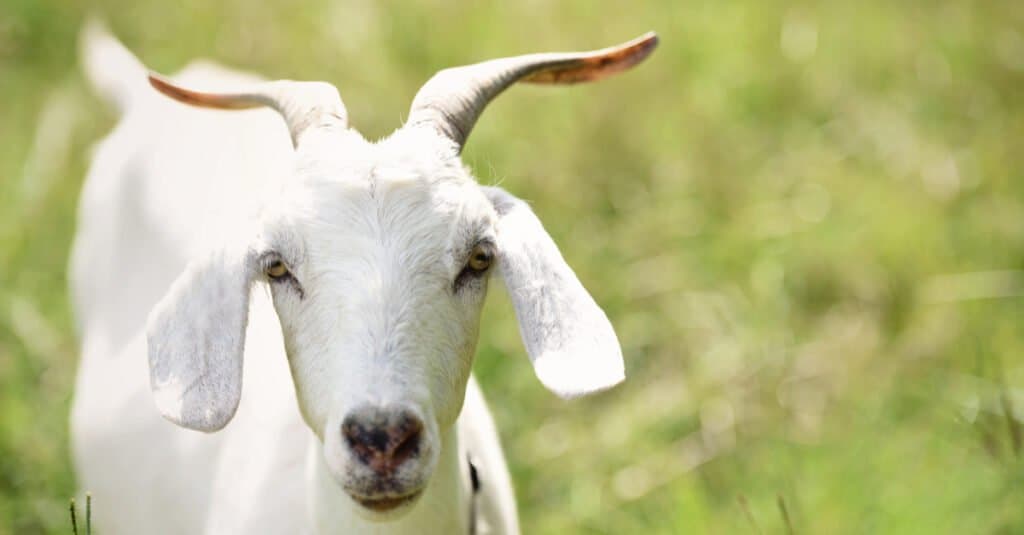
Male and female goats both naturally have horns.
©TanyaCPhotography/Shutterstock.com
1. Both Male and Female Goats Have Horns
Contrary to popular belief, both male and female goats have horns! Female goats typically have smaller horns than do males, though they’re still large enough to do damage. If goats of different sexes are not standing side-by-side, observers might have a difficult time telling them apart just by this feature.
Thankfully, there are other ways to differentiate between male and female goats. The most reliable method is to look under the tail. Male goats will have a single hole under their tails, which is the anus. Females will have two holes: one for the anus and the other for the vagina. Another method is to look for the scrotum on intact males or the udder on females. Additionally, male goats give off a strong, musky odour from their sex glands during mating season.
2. Goat Horns Are Made of Bone and Keratin
Goat horns are incredibly strong, and with good reason. The core is made of thick, live bone growing from the goat’s skull. This bone is covered by a layer of keratin. Keratin is the vital component in hair, fingernails, hooves, and claws. This combination allows the goat to use its horns to vigorously butt and jab.
The horn’s outer layer is mostly insensitive to pain. However, the bone underneath houses blood vessels, tissue, and nerves. Any damage to the horn will cause pain, and attempts to remove the horn completely can be agonizing for the goat.
3. Goat Horns Never Stop Growing
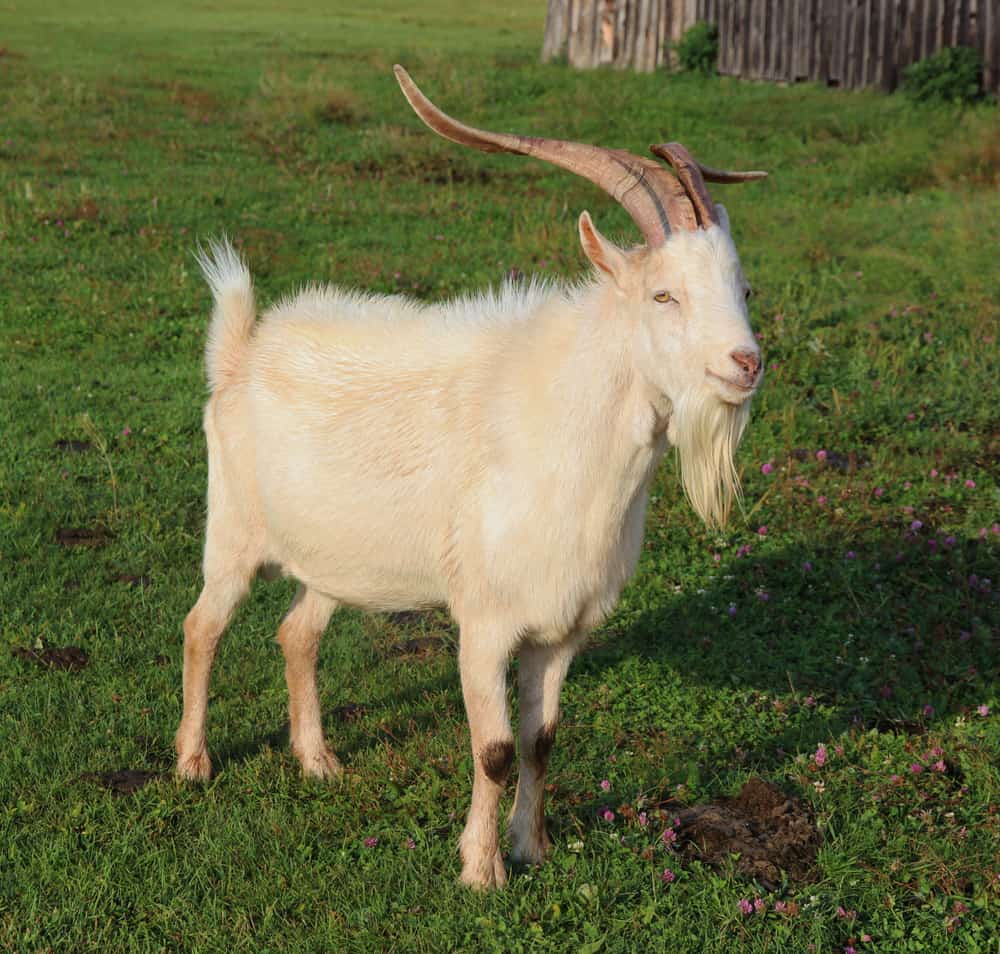
Horns continue to grow throughout a goats life.
©Anna-Artmade/Shutterstock.com
That’s right, goat horns continue to grow as long as the goat is alive! It’s even possible to tell a goat’s age by counting the annual growth rings on its horns. As the goat ages, horn growth slows lengthwise and the horn begins to grow thicker and stronger around its base.
Despite this continual growth, horns won’t usually grow back if they break off. If the horn is broken off the skull, it may even expose the sinus cavity. This needs to be covered until the bone grows back to prevent further injury and infection.
4. Hornless Goats Exist
Some goats are naturally born without horns. Breeders call these “polled” goats, which are similar in every other way to regular goats. Their hornless heads are the result of a recessive gene in their parents. It’s possible to mate either polled goats or goats with the gene to produce kids without horns. For some livestock owners, this is a desirable trait, as it means their goats won’t be able to do damage to other animals or property. Others, however, consider it a disadvantage as many polled goats are unable to reproduce.
There is no breed of goat that only produces polled kids. Every breed is horned except for various individual members.
5. Goat Horns Help Regulate Body Temperature
Strangely enough, goat horns actually help regulate a goat’s body temperature. The blood vessels in the horns carry blood from the body close to the keratin sheath, where it loses heat. Then the cooled blood returns to the body. It’s nature’s all-natural air conditioning for goats. Without this process, they struggle to stay cool.
For this reason, some goat breeds should never be dehorned. The Angora goat, which has a thick, luxuriant coat, is one such type. They have no other way to keep cool in hot weather and may easily perish from overheating. Goats that live in hot climates are particularly susceptible to this condition.
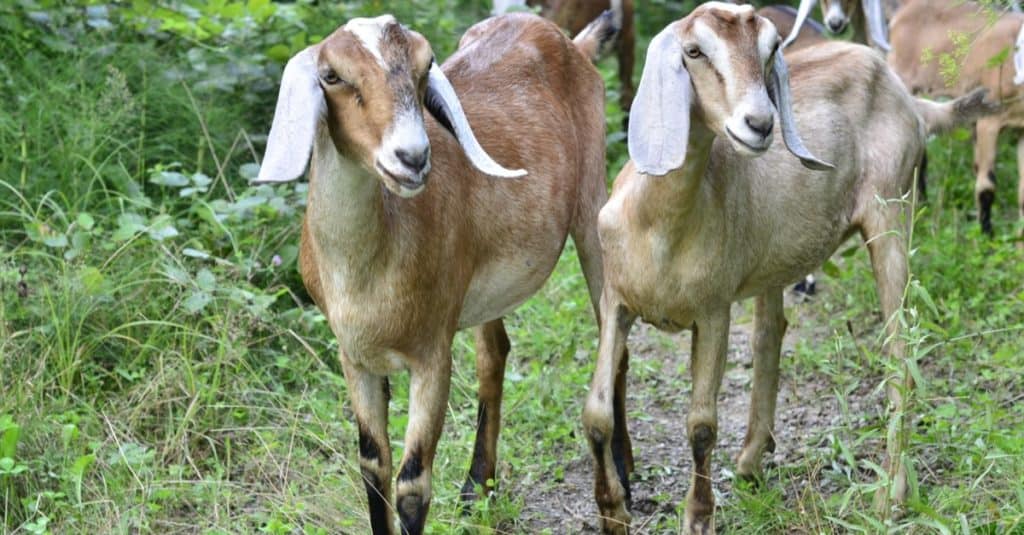
Many goats are dehorned for safety reasons either as kids or as adults.
©Zhanna Shamrai/Shutterstock.com
6. Goats Use Their Horns to Communicate
Goats are lively, playful, social creatures capable of feeling and expressing emotion. In addition to their voices and facial expressions, goats also communicate their state of mind with their horns. Headbutting is a common behaviour that can have a variety of meanings. Goats may headbutt humans or each other to express affection. It may also be an invitation to play.
However, sometimes a headbutt carries a more serious message. Goats maintain a strict social hierarchy among themselves, enforcing it with their horns. Though goats don’t often impale each other, they may push and butt to indicate dominance. Stronger goats may bully weaker males into submission.
Though it’s a rare occurrence, goats sometimes impale humans, whether intentionally or by accident. This is one reason livestock owners are commonly in favour of dehorning.
7. Many Domestic Goats Are Dehorned
Removing a goat’s horns usually occurs in one of two scenarios. The first is shortly after birth. The process of disbudding involves preventing a kid’s horn tissue from developing into nubs and eventually full-blown horns. To ensure they do not spout, disbudding typically takes place no later than 3 weeks after birth. Practitioners cauterize the horn tissue either with hot irons or, less frequently, with caustic paste. The procedure is painful.
The second scenario involves removing an adult goat’s fully-formed horns. This is the process of dehorning, or cutting off the horns in their entirety. The procedure is extremely painful and risky, more so than disbudding. However, both procedures are controversial.
Livestock owners typically choose to practice disbudding and dehorning to prevent goats from causing injuries to themselves or others. It also minimizes the risk of property damage. As a result, the majority of livestock goats are hornless.
8. Baby Goats Are Born Hornless
Thankfully for the mother goat, all baby goats are born hornless. Instead, they have horn tissue that, over time, becomes attached to the skull and forms nubs. It takes about 3 weeks for these nubs to appear. Baby goats learn to use their horns by playing with other kids and watching their mothers.
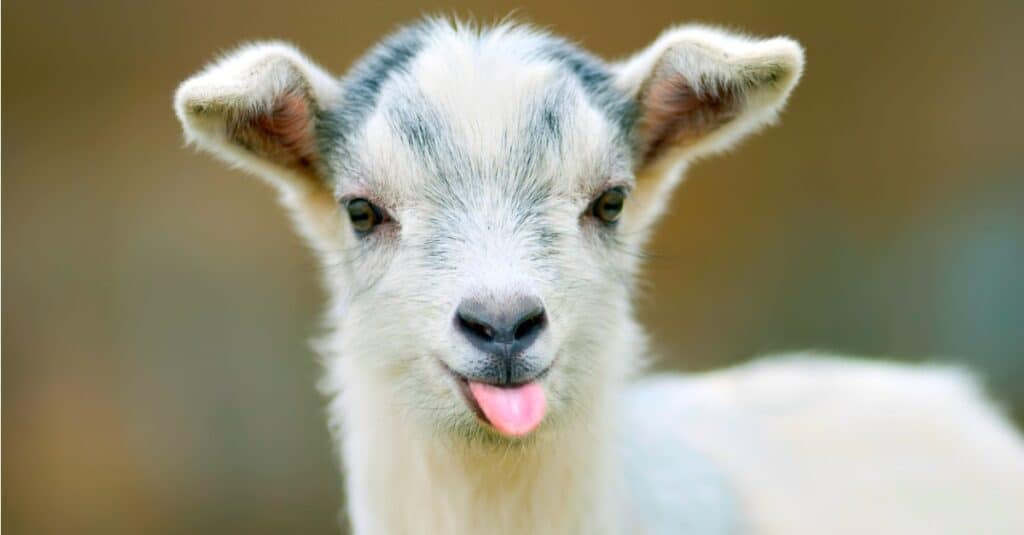
Baby goats (kids) are born without horns, though they develop horn nubs by 3 weeks of age.
©iStock.com/maximili
9. Goat Horns Come in Different Shapes
Goat horns come in a couple of different shapes including straight, curved, and corkscrew. Breeds like the bulky Markhor goat feature majestic corkscrews. Nubian goat horns, on the other hand, are elegantly curved. Other breeds have simpler, straighter appendages, though even these may have a slight curl to them.
10. Goats Don’t Shed Their Horns
Many horned species like deer, moose, and caribou shed their horns seasonally. However, for goats, these are permanent fixtures. If disbudding, dehorning, or breakage doesn’t occur, the horns will remain firmly rooted to the skull.
Goats make loveable pets and useful, productive livestock. You may even find yourself on the receiving end of a friendly headbutt. Just make sure to watch out for those horns!
Bonus: What Are the Different Types of Goat Horns?

The Pakistani markhor goat has stunning corkscrew-shaped horns.
©Tadoma/ via Getty Images
There are generally eight different types of goat horns. Below is a list of each with a bit of interesting info about each.
- Straight Horns Varied thicknesses or lengths can be seen in these straight horns, displayed in goat breeds like the pygmy goat.
- Spiral Horns These elegant horns have tight spirals or curls with pointed tips. Breeds like the Siberian ibex sport spiral horns.
- Twisted Horns An irregular twisted or spiral shape with varying degrees of thickness, based on breed, characterizes this horn. You’ll see twisted horns on Nubian goats.
- Corkscrew Horns These horns resemble a corkscrew you’d use to pop open a wine bottle, and can vary from short to elongated. A good example of this horn shape can be seen on Pakistani markhor goats.
- Sickle-Shaped Horns Resembling the shape of a sickle, these horns curve backward, then forward, with varying curvatures and lengths. Check out Boer goats for an example.
- Semi-Curved Horns Saanen goats have semi-curved horns, which are smooth and have a moderate curve pointing upward or slightly backward.
- Hooked Horns Think of a fish hook for an idea of this type of horn shape, seen in a Chamois goat-antelope.
- Upward-Curved Horns These non-spiral horns curve upwards, and can be seen in Nigerian dwarf goats.
The photo featured at the top of this post is © Elina Litovkina/Shutterstock.com
Thank you for reading! Have some feedback for us? Contact the AZ Animals editorial team.





